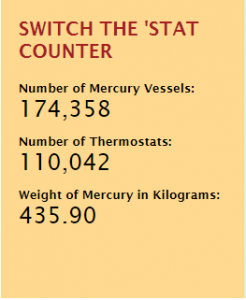There are a number of common household products that may contain mercury. Mercury has been used in a variety of products because it is a good conductor of electricity and it reacts predictably to temperature and pressure changes. The chart below provides information that will help you identify potential mercury-containing products in your home, as well as determine mercury-free alternatives.
| Product Type | Description | Amount of Mercury | Mercury-Free Alternatives |
|---|---|---|---|
| Thermometers | A traditional, mercury-in-glass thermometer is a thermometer containing mercury in a glass tube. Calibrated marks on the glass tube allow the temperature to be read by the length of the mercury within the tube, which varies according to the heat given to it. | A typical mercury-containing fever thermometer contains approximately 0.7 grams of mercury but larger thermometers can contain as much as 3 grams of mercury. | Digital electronic thermometers. Glass gallium-indium-tin thermometers. Flexible forehead and ear canal thermometers. |
| Thermostats | A mercury-containing thermostat contains an internal mercury switch (mercury in a sealed glass bulb) that controls the flow of an electrical current. The weight of the mercury dropping moves the bimetal spring, creating an on/off switching action. | Each switch contains approximately 2.5 grams of mercury and each thermostat contains 1-4 switches. | Mechanical thermostats that contain snap switches. Electronic programmable thermostats also provide an energy conservation component by allowing for automatic temperature adjustments. |
| Older Appliances | Mercury tilt switches were used in chest freezers made before 2000 to switch on the light fixture when the lid was lifted. They were also in washing machines made before 1990 to switch them off when the lid was lifted or when the load was unbalanced. | Each switch contains approximately 1 gram of mercury. Chest freezers typically contain 1 switch and washing machines contain 1-2 switches. | Appliances that contain electrical switches. |
| Older Vehicles | Mercury tilt switches were used until 2003 for hood and trunk convenience lighting. When the hood or trunk reached a certain angle, the mercury makes an electrical contact and turns the light on. In the anti-lock braking system, the mercury switch was used until 2003 to detect deceleration rates and to disengage four-wheel drive during slipping and re-engage after the event has passed. | There is 1 switch per convenience lighting assembly and each switch contains approximately 0.85 grams of mercury. There are usually 3 switches per ABS system, with 0.85 grams of mercury per switch. | Pendulums or ball bearings are used as alternatives for the mercury-containing convenience lighting switches in all 2004 and newer vehicles. Anti-lock braking systems are now computerized. |
| Batteries | While the manufacture of mercury oxide batteries was discontinued in Canada as of January 1996, mercury is still found in some alkaline-manganese batteries and most types of button cell batteries that are sold in Canada. Many counterfeit batteries do not meet mercury limits, even though they are marketed as if they do. Some companies import batteries from non-North American sources and these batteries may contain high levels of mercury. | Zinc air batteries contain 8.5 mg of mercury and account for 86% of all button cell batteries sold in Canada. Silver oxide batteries contain 2.5 mg of mercury and account for 9% of all button cell batteries sold in Canada. Alkaline batteries contain 10.8 mg of mercury and account for 5% of all button cell batteries sold in Canada. | North American battery manufacturers have committed to producing mercury-free button cell batteries by June 30, 2011. |
| Lamps — compact fluorescent light bulbs (CFLs), fluorescent tube lights, high intensity discharge (HID) lamps | A typical fluorescent lamp is made up of a phosphor-coated glass tube with electrodes located at either end. The lamp contains a small amount of mercury in vapour form. When a voltage is applied to the lamp, the electrodes energize the mercury vapour, causing it to emit ultraviolet (UV) energy. The phosphor coating absorbs the UV energy, causing the phosphor to fluoresce and emit visible light. Without the mercury vapour to produce UV energy, there would be no light. | CFLs contain 1-25 mg of mercury. lights contain 3-50 mg of mercury. HID lamps contain 22-225 mg of mercury. | Light emitting diodes (LEDs). |
